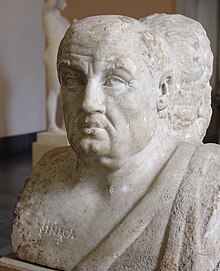Our website is made possible by displaying online advertisements to our visitors.
Please consider supporting us by disabling your ad blocker.
Senecan tragedy
This article needs additional citations for verification. (July 2008) |

Senecan tragedy refers to a set of ten ancient Roman tragedies,[1] eight of which were probably written by the Stoic philosopher and politician Lucius Annaeus Seneca.[2] Senecan tragedy, much like any particular type of tragedy, had specific characteristics to help classify it. The three characteristics of Senecan tragedy were: five separate acts, each with a Chorus; recounting of ‘horrors’ and violent acts, which are usually done off-stage; and some sort of parallel of the violence that occurred.[3] Only the Phoenissae departs from the five act structure.[4] In the English literary canon, Seneca appears as a major influence on later texts about revenge, such as Titus Andronicus and The Crying of Lot 49.
- ^ "Senecan tragedy | Roman, Stoic & Tragic | Britannica". www.britannica.com. Retrieved 24 May 2024.
- ^ Ker, James (5 August 2010). "Review of Seneca and the Idea of Tragedy". Notre Dame Philosophical Reviews. ISSN 1538-1617.
- ^ "Senecan tragedy". Oxford Reference.
- ^ Tarrant, R. J. (1978). "Senecan Drama and Its Antecedents". Harvard Studies in Classical Philology. 82: 213–263. doi:10.2307/311033. JSTOR 311033.
Previous Page Next Page


